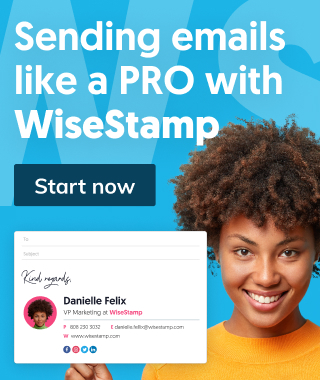How to use Fogg’s behavior model to increase conversion
Fogg’s behavioral model holds lots of invaluable persuasive techniques and concepts that can be used to increase sales in marketing and advertising. Learn how.
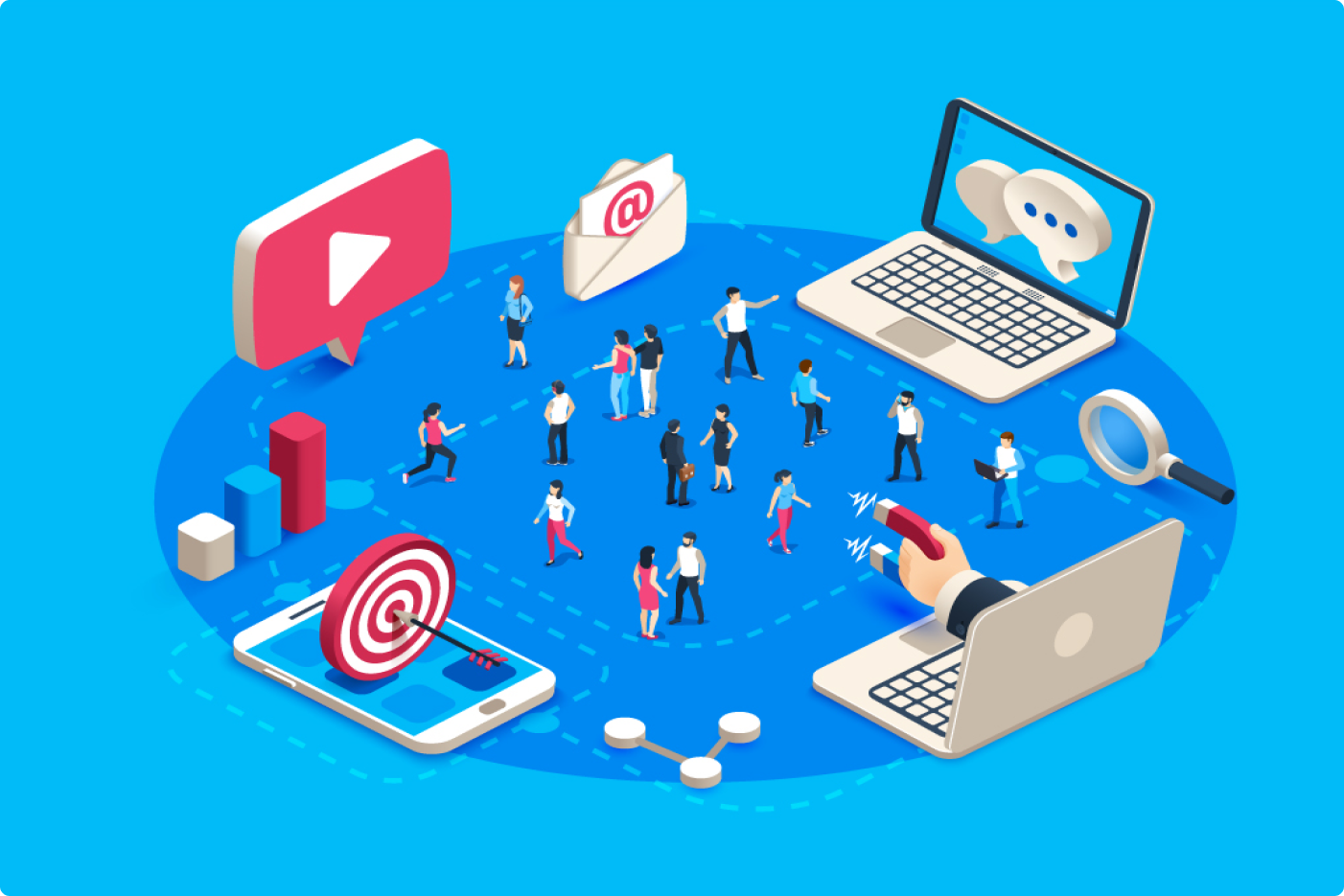
We recently had a look at Fogg’s seven persuasive technology tools and how they can be used to increase sales using advertising. Now, we’re going to take a look at yet another one of Fogg’s theories, namely his behavior model.
The main goal here with BJ Fogg’s behavior model, which we’ll start looking at closely in a moment, is to get people to act or behave in a certain way. Ideally, you want to inspire behavior that translates into higher conversion rates.
You might think that there are tons of different ways to reach this goal, and you’re right, in a way. However, Fogg’s behavior model shows that there are fundamental ways in which humans behave that don’t really change that much.
Fogg’s behavior model demonstrates that there are very specific elements, three actually, of human behavior that need to be present in order for a decision to be made. So, exactly what are the three elements of BJ Fogg’s behavior model? Let’s take a closer look at each one.
The 3 Elements of B.J. Fogg’s Behavior Model?
Fogg’s behavior model is made up of three elements that predict behavior: motivation, ability, and triggers (also called prompts). We’ll get into each one of these in a lot more detail soon. However, it’s important to understand that, according to Fogg, all these 3 elements need to align in the right way in order to influence someone’s behavior.
Fogg breaks his behavior chart into a simple formula:
Behavior = motivation x ability x prompts
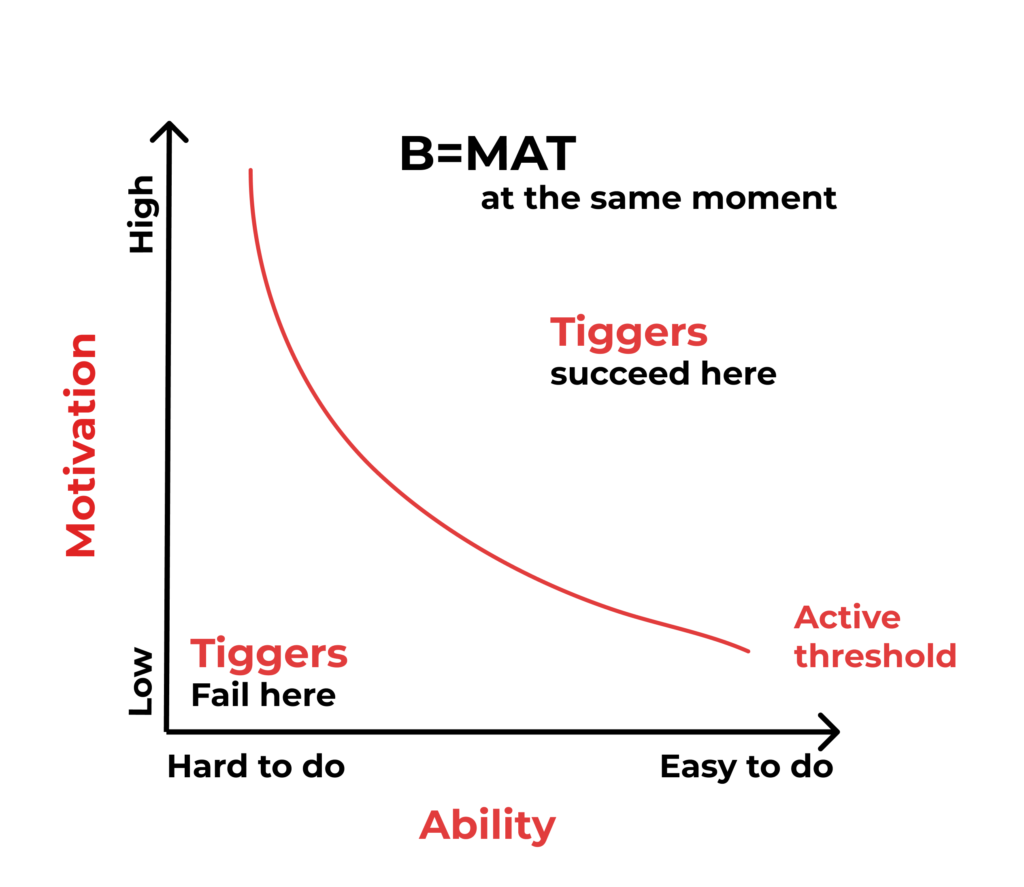
To simplify this formula and the whole concept, if there is enough motivation for behavior and there is an equal ability to perform it, then the only thing left to trigger the behavior is prompt.
To illustrate this model, have a look at the following video that uses the example of answering a ringing phone and puts motivation, ability, and prompts in context.
Seems simple enough, but it becomes a little more involved when you break down each element and all its factors.
Fogg behavior model in 2 minutes and 30 seconds

Motivation
When he talks about motivation, Fogg is referring to the underlying drives that motivate you. He divides motivation into three separate drives: sensation, anticipation, and belonging. These drives can also be described as physical, emotional, and social.
1. Sensation
Sensation represents the physical level of motivation. It’s normal for people to want to participate in things that bring them pleasure and stay away from things that don’t. Games work really effectively here since there are usually built-in risk and reward systems. From a marketing perspective, if you offer consumers incentives to complete their desired behavior, then this increases their motivation.
2. Anticipation
This is the more emotional element of motivation and relies on feelings such as fear and hope. Hope is one of the strongest motivators since it helps provide a person with a sense of meaning.
If we think of this in an actionable way, then it would look something like a company offering a product or service that makes consumers feel hopeful that they can achieve their desire or goal by using what you’re offering. Take a 30-day fitness course, for example. By showing your audience they can hope to achieve their goal, suddenly their motivation to sign up increases.
3. Belonging
Belonging represents the social factor in motivation. People naturally want to feel like they belong. By having a community where no one is rejected, they’re more likely to feel motivated to continue engaging with your content. This is why social media marketing works so well.
Consumers find groups of like-minded individuals on social platforms and regularly engage with their content. So, if companies are in the same space, it works to motivate an audience to interact with that company since they both belong to a specific group of people.
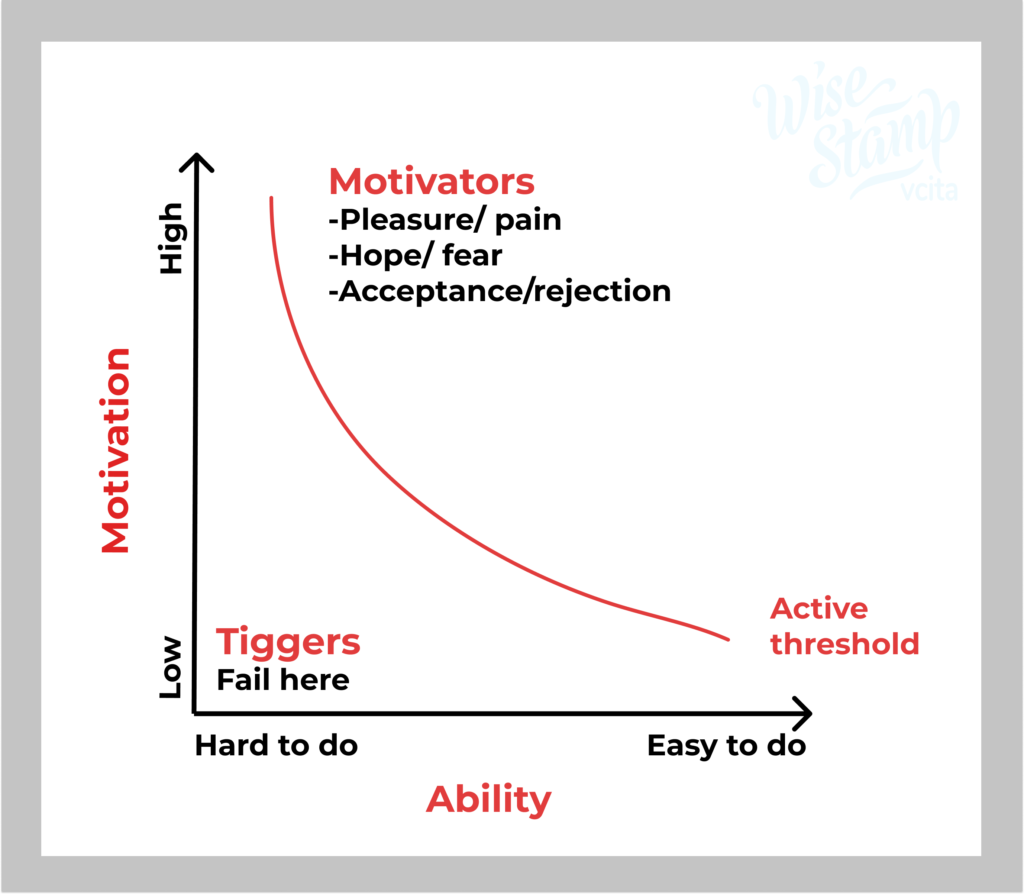
Ability
If a person is unable to perform the desired behavior because of a lack of ability, then all other elements don’t matter. That’s why it’s important to understand the factors that stand in the way of a person’s ability.
When it comes to creating a website, campaign, or any sort of marketing content, you want to keep these ability blockers in mind so that you can avoid them. Not addressing these ability blockers can lead to lower conversion rates, so it’s important to ensure that users can still have the ability to perform the desired behavior.
1. Time
These days, no one wants to spend a lot of time sifting through a website to find the information they’re looking for. Therefore, it’s so important to make sure that a task can be completed in a short amount of time. This might look like short lead capture forms, so instead of asking for all kinds of information like an address, phone number, or date of birth, simply ask for a name and email.
2. Money
If people aren’t willing to spend a lot of time, then they’re definitely not likely to spend a lot of money at the beginning of a process. Something that costs nothing is more likely to lead to the desired behavior than if the cost is prohibitive.
For example, you’re likely to get more users to sign up to a loyalty or rewards program if there are no initial start up costs rather than making someone pay upfront to join.
3. Physical Effort
When we talk about the physical effort in the realm of digital marketing, it refers mostly to the number of clicks a person has to make before getting to the desired location. Of course, the fewer clicks, the higher the chance the consumer will perform the goal behavior.
If your website has one-click checkout, as Amazon does, then you’re eliminating the effort needed to achieve the desired behavior, which for the consumer is completing a purchase and for you is increasing your conversion rate.
4. Mental Cycles
Though clicks aren’t quite physically exerting, what’s more, likely to lose motivated users is if you’re exhausting them. That’s why you should always write out directions succinctly and be clear about what people can expect from the outcome. There should be no guesswork involved
For example, if your goal is to have clients open an account, guide them through a brief step-by-step sign-up process and then provide them with a quick account tour once they’re signed up.
5. Social Deviance
This one is very simple. Don’t ask your audience to go against the norm or perform actions that are not socially acceptable. Sure, some people like it when brands play into individual differences or are unique, but you shouldn’t go too far in that you’re promoting actions that alienate or offend people.
6. Non-routine
People are comfortable with actions they’re already familiar with, so in order to get users to complete your intended behavior, there’s no need to reinvent the wheel. Look at what competitors are doing in terms of web design, campaigns, or products they offer, and ask yourself if your products are in-line with theirs. This doesn’t mean they should be the same, but there should be a basic degree of familiarity and routine.
For example, if you’re designing a website for your company, don’t design the menu and search bar in places where users wouldn’t expect them to be. This will make them frustrated and confused and might motivate them to give up.
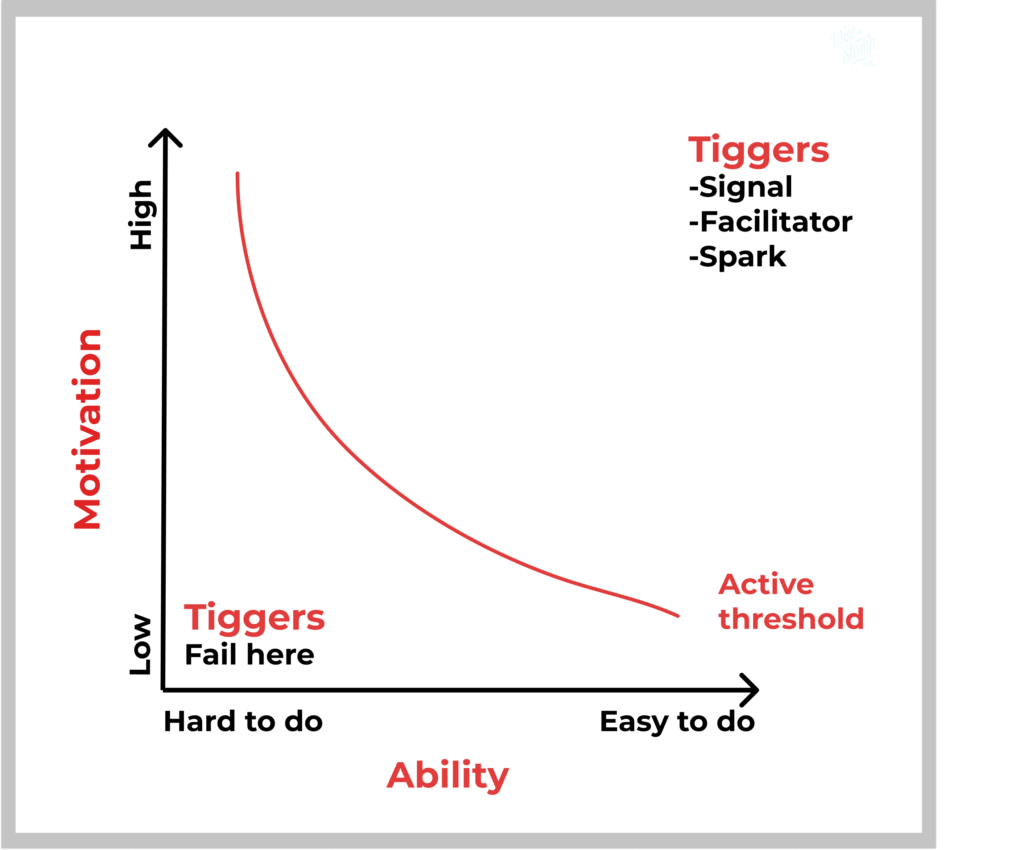
Triggers
Fogg’s behavior model triggers can be compared to a call to action. Once users pass the motivation and ability stages, the final behavior needs to be triggered by an enticing prompt. The following three types of triggers, or calls to action, use a combination of both motivation and ability to result in a prompt that works best with each user.
1. Facilitator
You’ll need a facilitating prompt when there is a lot of motivation, but a lack of ability. You’ll need to sort of take the user by the hand and guide them through a process very carefully by using very clear prompts. These prompts can be clear instructions, flashing arrows, or pop-ups with vital information.
2. Spark
On the flip side, some users lack a decent amount of motivation but they have the complete ability. In this case, a spark is meant to increase the motivation, often by playing into a person’s emotion by making them care. In this step, you’ll need to be able to show your value and then continue with clear and functional next steps.
Basically, it should focus on playing up the value and accessibility of a first step, and then later steps can help further a user’s motivation.
For example, getting a user to sign up for your newsletter by offering an incentive like a discount code will make them more motivated to give you their email address.
3. Signal
Some people have both the right amount of motivation and the right amount of ability, and this makes it easier for you. The only thing that they’re missing is a clear CTA, so make sure you’re providing a noticeable and effective CTA that aligns with their motivation and abilities.
How to Use Fogg’s Behavior Model in Practice
Now that you have a better understanding of Fogg’s behavior model and each element that it’s made up of, you’re probably already thinking of ways you can put this knowledge into practice.
Once you’ve implemented Fogg’s behavior model in your next campaign or advertisement, you may think that your work is done. However, in order to ensure that your campaign runs smoothly and that you’ll achieve your desired behavior, such as a higher conversion rate, take some time to analyze your processes and think like a user. Ask yourself the following questions:
- Motivation: Have we done enough to motivate users to perform our desired behavior?
- Ability: Have we analyzed and eliminated any ability-blockers that would stop our users from achieving the desired behavior?
- Triggers: Are we using our prompts and CTAs effectively in a way that promotes users completing the final desired behavior?
If your answer is yes to all of these questions, then you’re ready to take the next step and put your plan into action. So, how can you use this behavior model to increase conversion? Let’s look at BJ Fogg’s behavior model example in the real world.
Let’s say you’re running a Facebook ad for the purpose of increasing conversions for your website where you sell sneakers. Your ad was well-designed by your graphics and content teams, but it just doesn’t seem to be affecting the conversions in the way you hoped. Here are some steps you’d take according to the behavior model.
- Using Fogg’s behavior model, you would first figure out what a user’s motivation would be to click on your ad while scrolling through their feed. One way to do this would be to instill a sense of community by displaying the ad to the “sneakerhead” community and tailoring your ad to their preferences.
- Once the motivation is clearer and users are more interested to click on your ad, make sure that your website doesn’t present any impediments to a user’s ability. Decrease the number of clicks someone would need to find the right pair of sneakers they’re looking for by adding product filters to your catalogue.
- Finally, when a user gets to the product page they want, add a motivating prompt, like an “add to cart” CTA, or even incentivize them with a discount on this purchase if they check out within the next X amount of time.
This is just one example of how to implement Fogg’s behavior model, but there are many factors that can affect how you use it. Such as your audience, your goal, or even your products. Play around with different elements of Fogg’s behavior model until you find a formula that brings you success.
Bottom Line
Behavior is a chain of events, and if at any point the chain is weaker due to a lack of motivation, a lack of ability, or ineffective triggers, then the chain will break. Each element of Fogg’s behavior model works together and depends on each other in order to reach the desired behavior.
So, if you have a specific goal in mind, like increasing conversions, start by thinking of what a user’s behavior would need to look like in order to achieve this goal.
Once you start using this behavior model for one task, it’ll become more intuitive to implement it across your business in more ways than only your marketing strategy or in campaigns, but also in other ways, like business operations or even employee satisfaction.


